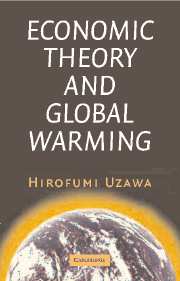Book contents
- Frontmatter
- Contents
- List of Tables and Figures
- Preface
- Introduction: Global Warming: Problems and Perspectives
- 1 Global Warming and Carbon Taxes
- 2 Pareto Optimality and Social Optimum
- 3 Global Warming and Tradable Emission Permits
- 4 Dynamic Analysis of Global Warming
- 5 Dynamic Optimality and Sustainability
- 6 Global Warming and Forests
- 7 Global Warming as a Cooperative Game
- Summary and Concluding Notes
- References
- Index
Introduction: Global Warming: Problems and Perspectives
Published online by Cambridge University Press: 03 December 2009
- Frontmatter
- Contents
- List of Tables and Figures
- Preface
- Introduction: Global Warming: Problems and Perspectives
- 1 Global Warming and Carbon Taxes
- 2 Pareto Optimality and Social Optimum
- 3 Global Warming and Tradable Emission Permits
- 4 Dynamic Analysis of Global Warming
- 5 Dynamic Optimality and Sustainability
- 6 Global Warming and Forests
- 7 Global Warming as a Cooperative Game
- Summary and Concluding Notes
- References
- Index
Summary
INTRODUCTION
The relations between the environment and processes of economic development have in recent years become increasingly complex. This is primarily due to the accelerated pace of economic development in many parts of the world in the last several decades, as manifested by the rapid rates at which basic statistical indicators such as gross domestic product, the volumes of industrial outputs, and the degree of urbanization have been increasing (see, e.g., World Bank 1999). This phenomenon is also closely related to the institutional arrangements, both in capitalist and former socialist countries, concerning the allocation of both privately owned and publicly managed resources.
During the last three decades, in particular, we have also seen a significant change in the nature of the social, economic, and cultural impacts on the natural environment during the processes of economic development. This is symbolically illustrated by the agendas of two international conferences convened by the United Nations – the Stockholm Conference in 1972, on the one hand, and the Rio Conference in 1992, on the other.
The Stockholm Conference was primarily concerned with the degradation of the natural environment and the ensuing health hazards caused by the processes of industrialization during the 1960s.Then the degradation of the natural environment was mainly caused by the emission of chemical substances such as sulfur oxides and nitrogen oxides that by themselves are toxic and hazardous to human health and the biological environment. In the Rio Conference, on the other hand, the main agenda focused on the degradation and destabilization of the global environment such as global warming, the loss of biodiversity, desertification, and other global environmental issues stemming from intensified industrialization and extended urbanization.
Information
- Type
- Chapter
- Information
- Economic Theory and Global Warming , pp. 1 - 21Publisher: Cambridge University PressPrint publication year: 2003
